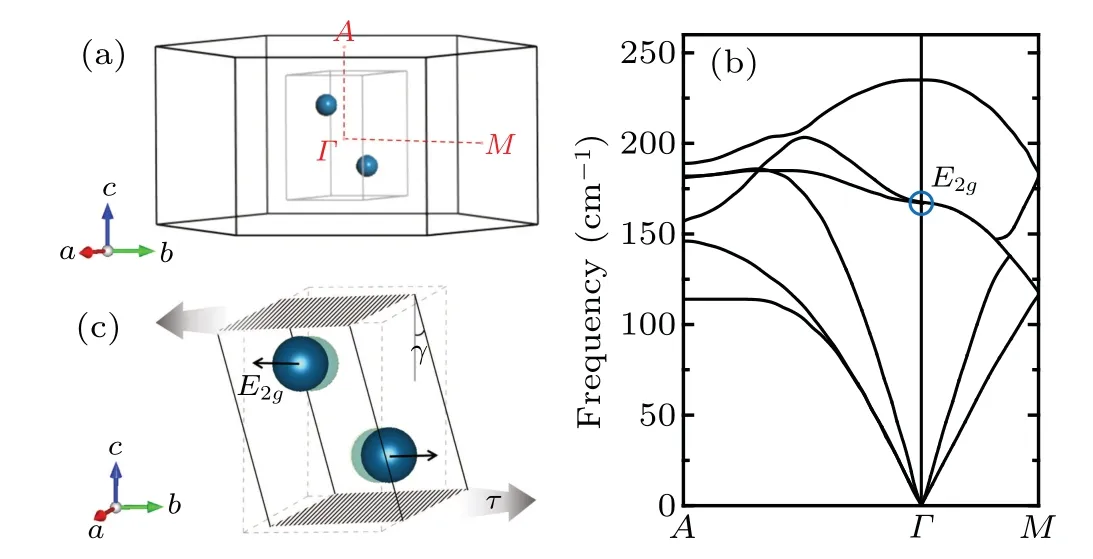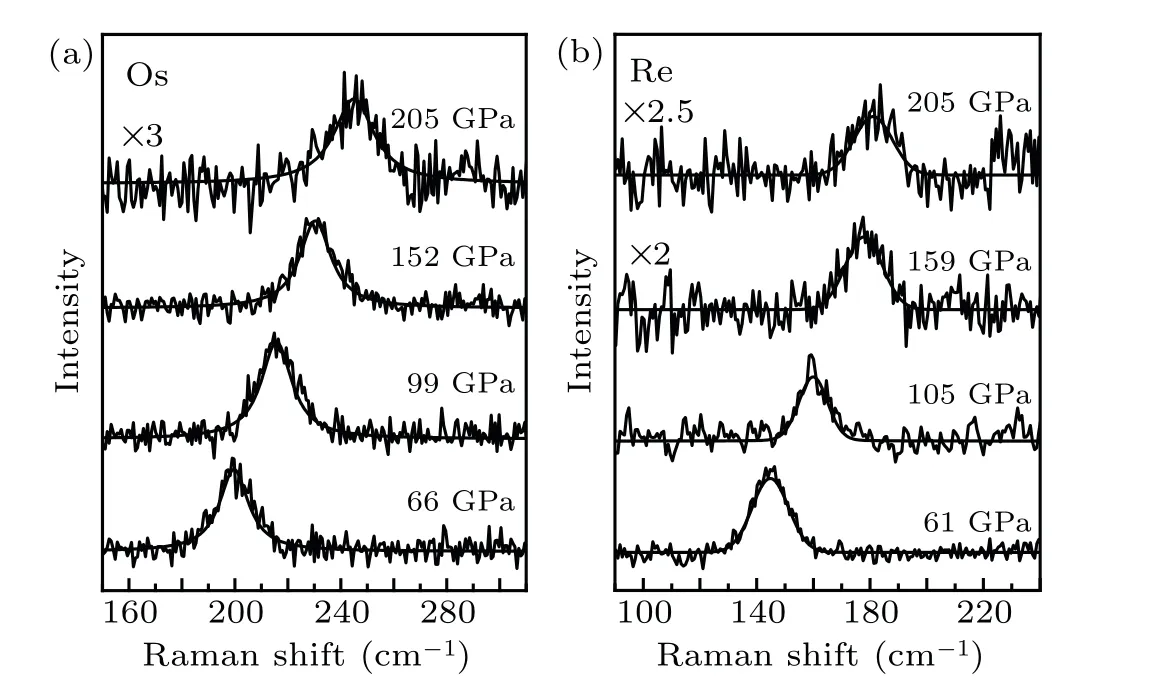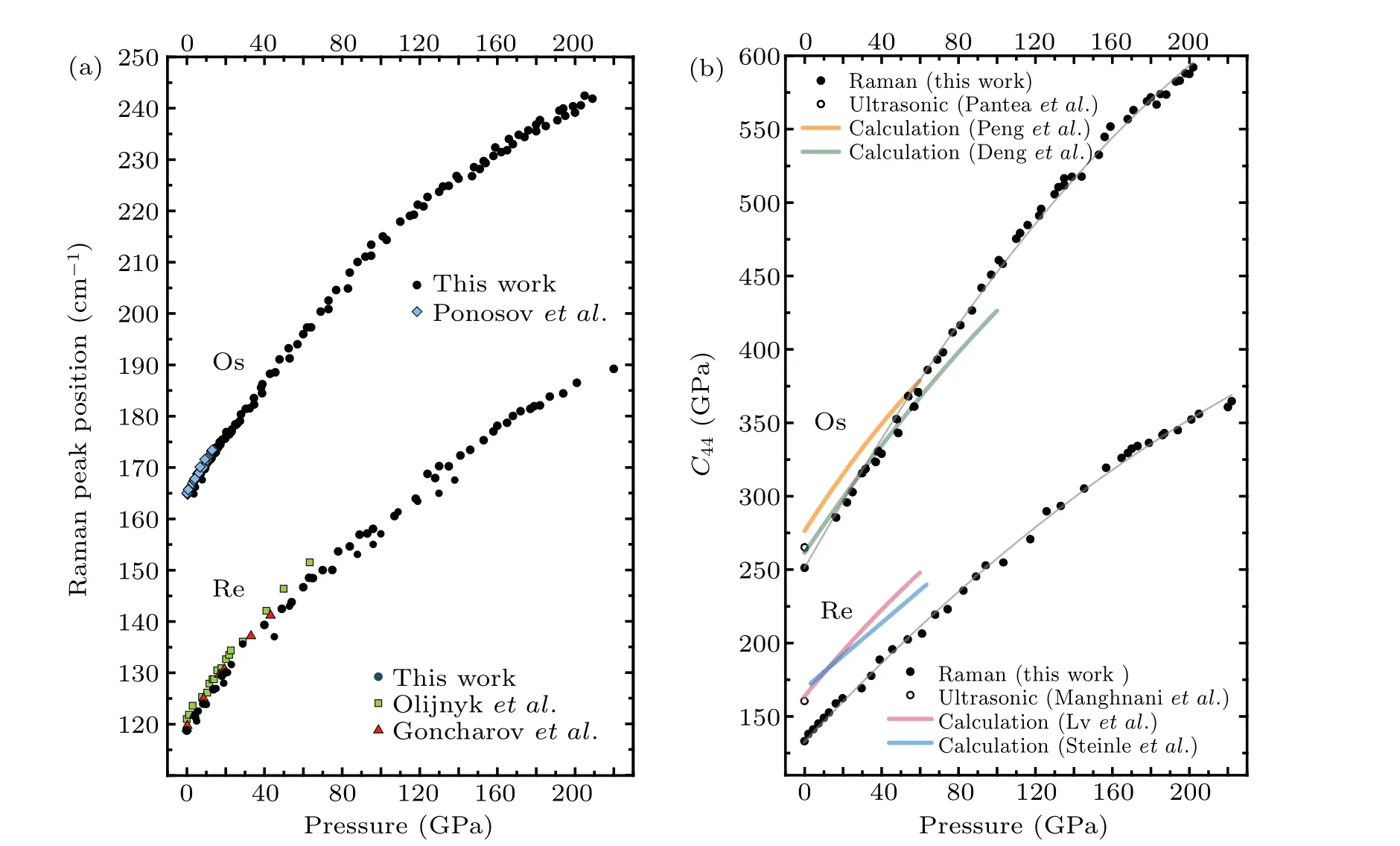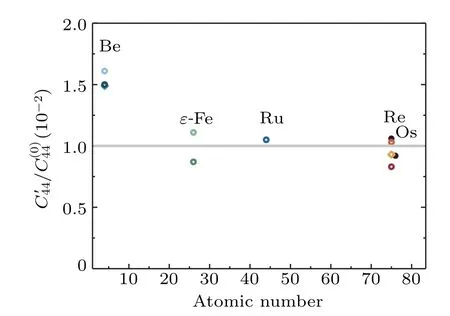High-pressure Raman study of osmium and rhenium up to 200 GPa and pressure dependent elastic shear modulus C44
2022-03-12JingyiLiu刘静仪YuTao陶雨ChunmeiFan范春梅BinbinWu吴彬彬QiqiTang唐琦琪andLiLei雷力
Jingyi Liu(刘静仪), Yu Tao(陶雨), Chunmei Fan(范春梅),Binbin Wu(吴彬彬), Qiqi Tang(唐琦琪), and Li Lei(雷力)
Institute of Atomic and Molecular Physics,Sichuan University,Chengdu 610065,China
Keywords: hexagonal close-packed(HCP)metals,osmium,rhenium,high-pressure Raman scattering,shear modulus C44
1. Introduction
Hexagonal close-packed (HCP) osmium (Os) and rhenium(Re)are an important category of rare metals which belong to the platinoid 5d transition elements category with ultrahigh density and cohesive energies at ambient pressure.[1-16]In the past decades,Os and Re metals have attracted an important attention due to the extensive scientific and engineering applications.In order to understand their exotic properties,the pressure parameter is considered as a fundamental thermodynamic variable. The effect of pressure on elastic properties of a metal is essential for understanding the mechanical stability.The elastic properties of metals under high pressure are desirable not only for material research itself,[17]but also because it may allow providing new insights into the fundamental effects of the high-pressure experiments on the atomic structure of solids and on possible variation of atomic distribution within crystal sublattices.
One of the interesting features of Os and Re materials is that they are able to retain the HCP phase (space groupP63/mmc)upon very high applied pressure-values.[13,18-20]As shown in Fig. 1, the lattice of HCP metals comprises two atoms per unit cell (Fig. 1(a)). The only Raman-activeE2gmode in center of Brillouin zone (Fig. 1(b)), correlated with the shear vibration between different layers, provides direct information about the elastic properties(Fig.1(c)). Noteworthy,C44is the only elastic constant that could be measured in experiments as an independent modulus for HCP metals.Namely, the pressure dependence of the shear modulusC44can be deduced from the Raman phonon frequency of theE2gmode(Fig.1(c)).
In group theory, each set of nuclei on sites of symmetryD3hgives rise to six normal modes of zero wave vectorA2u+B1g+E1u+E2gdepicted as irreducible representations.Among those modes, the doubly degenerateE2gmode is Raman active, corresponding to vibrations of successive hexagonal planes against each other (Fig. 1(c)). TheE2gRaman mode reflects the shear vibration between different layers of atoms in HCP metals. By considering Os as a typical example, in Fig. 1(b), it is possible to notice its dispersion curves,which include six branches,and at high symmetry pointsΓthe acoustic and optical branches coincide. A phonon branch at the center of the Brillouin zone is a shear mode and the elastic shear modulus is related with the slope of the zone-center TO mode(Fig.1). It is possible,therefore,for the vibration characters of HCP metals to be observed by Raman spectroscopy.
Due to the high reflectivity and strong background from the diamond-anvil cell (DAC) or gaskets, high-pressure Raman scattering signals acquired from metals were hard to be distinguished. To prevent specular reflection from being directed to the spectrometer and reduce the signal from the diamond, a lateral excitation technology (typical 35°incidence angle for the exciting radiation) was used in high-pressure Raman experiments on HCP metals, such as Be,[21]Fe,[22]Re[23]and Os.[24,25]The Raman scattering on the metals,however, are limited by the detection based on conventional experimental set-up. Up to now, high-pressure Raman scattering on the HCP Os and Re is only extended to 60 GPa[25]and 138 GPa,[26]respectively. There are far narrow pressure ranges that need to be investigated, and this implies that the influence of pressure upon HCP metals’elastic properties has not yet been unambiguously determined.

Fig.1. (a)Brillouin zone of the HCP metal(space group P63/mmc), gray lines indicate the unit cell and blue balls indicate the metal atoms. The positions of representative high-symmetry points in the HCP Brillouin zone are plotted in red. (b)Typical phonon dispersion curves for the HCP metal(Os).[18]The circle points to the E2g phonon mode at the center of the Brillouin zone. (c) The atomic displacement for the E2g mode, and the ideal lattice model diagram of lattice shear stress. The uniaxial stress,τ,and the resulting normal strain,γ,have been labeled in the picture.
In this work, high-pressure Raman scattering from HCP metals Os and Re has been measured up to 200 GPa by using a DAC-based lateral excitation technology with 45°incidence angle for the exciting radiation,[27,28]and the shear modulusC44has been deduced from the measuredE2gphonon frequency, which provides an independent experimental approach besides other methods, such as ultrasonic experiments[29,30]and theoretical calculations[4,31-34]to investigate the elastic property of the important platinoid 5d transition elements. More importantly, it is valuable to speculate their elastic properties for HCP metals under high pressure.[35]
2. Experimental details
We studied the elastic properties of Os and Re through high-pressure Raman scattering measurements using symmetric-type DACs for different pressure ranges in at least seven independent runs. To prevent specular reflection from being directed to spectrometer and reduce the signal from the diamonds, lateral excitation technology with 45°incidence angle for exciting radiation was used for our high-pressure Raman experiments.[27,28]High-pressure Raman spectra of HCP metals were measured by using a custom-built confocal micro-Raman system optical assembly with a 532-nm excitation solid-state laser(RGB Laser System Nova Pro)and an EMCCD detector(Andor Newton DU970P-UVB).The size of the pinhole of spatial filter that placed in front of a spectrometer (Andor Shamrock SR-303i-B) was 10 μm. The spectral resolution was within±0.5 cm-1, and the spatial resolution was within±1 μm. The Raman system deviation had been corrected by employing a calibration method based on silicon wafer(520 cm-1).
Ultrahigh-purity synthetic diamonds with culet sizes of 50-500 μm were used to reduce the background and scattering effect. High-purity(99.99%purity)poly-crystalline metal powder samples were loaded in the DAC chamber, and three different pressure-transmitting media(a 3:1 methanol-ethanol mixture(M/E),argon and nitrogen)were used to yield quasihydrostatic pressure condition. For lower pressures, comparative large culet diamonds adopted T301 steel as gasket with thickness of about 40 μm. For higher pressures, a rhenium gasket was preindented to thickness of 20-30 μm and drilled with a chamber hole in diameter of 20 μm. The pressure was then calibrated at room temperature by the fluorescence of ruby[36]and the high-frequency edge of diamond phonon.[37-39]The diameter of the Raman laser spot was~5 μm, which is smaller than the sample size (>20 μm).This allowed to minimize the effect of the pressure gradient.
3. Results and discussion
Representative Raman spectra of HCP Os and Re at various pressures are shown in Fig.2. Upon the quasi-hydrostatic compression, the blue shifts are observed on the pressure dependence curve ofE2gmode due to the increase of repulsive forces between adjacent atoms. From the consideration that the solidification of pressure transmitting medium inevitably occurs at no more than 15 GPa,[40,41]the observed broadening of Raman peaks at high pressures could attribute to the microscopic deviatoric stress under the nonhydrostatic compression.

Fig. 2. The representative high-pressure Raman spectra spanning the pressure range covered of (a) Os and (b) Re, respectively. The solid lines are phenomenological fits(Lorentzians).
Figure 3(a) summarizes our experimental measurements of the high-pressure Raman scattering from HCP metals applied to Os and Re. As the pressure parameter was increased,theE2gRaman frequency was found to monotonically increase. The softening of phonon can attribute to the pressuredependent anharmonic effect.
A simplified physical model, as shown in Fig. 1(c), elucidates the relations of theE2gRaman mode and the elastic constantsC44, which can be determined by the following equation:[42]

wheremis the atomic mass of HCP metal,aandcare the unit cell parameters, andωis the measured frequency of the Raman phonon. In HCP metals, the elastic constantC44can be defined as the ratio of the uniaxial stress,τ, exerted on a thin rod to the resulting normal strain,γ. By using the lattice parameters in Refs.[11,14],we can calculate the pressure dependence of theC44of Os and Re up to 200 GPa, as shown in Fig. 3(a). Figure 3(b) shows the pressure-dependent shear modulusC44deduced from the measuredE2gRaman phonon frequency. Here we note thatC44,calculated via Eq.(1)from high-pressureE2gmode, can be fitted by two second-order polynomials,

Table 1 lists the elastic parameters for some typical HCP metals. With regard to the slope of the pressure dependence,elastic properties in HCP metals are suggested to be more complex and yield deviations of the first derivative of the elastic modulus,C′44, from the theoretical curve. In theoretical calculation, in comparison to real lattice dynamics, ideal lattice vibrational models ignore the effect of crystalline defects,large binding energy of bonds and electronic shells,and nextnearest-neighbor interactions,leading to the discrepancies between the theoretical calculation and our Raman-dependent value.As for the discrepancies between the experimental data,this value is lower than that of ultrasonic experiments, partly because of the anisotropic deformation of a HCP metal under compression and the differences between the state of stress on all crystallographic planes.[22,35]

Fig. 3. (a) Pressure dependence of the E2g Raman peak position of Os and Re, literature data (color symbols) are also shown for comparison. (b)Pressure dependence of the deduced elastic shear constant C44 of Os and Re, gray solid lines are guides to the eye (second order polynomials), open circles are the reported ultrasonic literature data at ambient pressure[29,30] and colored lines represent the theoretical calculated results.[31-34]

Table 1. Comparison of deduced and measured elastic constants for typical HCP metals.


Fig.4. The ratio of normalized elastic constant,C44,and its first derivative,C′44, as a function of atomic number for the typical HCP metals.The full circles are our data. The open diamonds and circles are the data obtained from ultrasonic[29,30] and Raman measurements in the literature,[21-23,25,27,44,45] respectively.
In this work,the shear modulusC44and the pressure slopeC′44for HCP Os and Re have been deduced from the acquired high-pressure Raman data. We notice that there is a positive correlation betweenC44andC′44for the HCP metals(Table 1).The ratio ofC′44toC(0)44reflects the elastic property of a metal,covering the range from 0.8×10-2to 1.6×10-2for those mentioned elements. As shown in Fig.4,this value is approximately equivalent to 0.01 with the increase of the atomic number, which means to a positive correlation betweenC44andC′44upon compression. The association of high value at ambient pressure and the comparatively strong increase under compression of the elastic parameter hints on a potential law about this important group of metals. The differences of the elastic properties between those HCP metals are probably attributed to the completion of the unlike valence electron configuration(for example s→d) transfer under high pressure, which even leads to electronic topological transition.[11]Thus,the consistence of the elastic properties might imply to the similar highpressure behavior for those HCP metals.
4. Conclusions
In summary, we have extended the direct measurements of phonon vibration frequency ofE2gand the information onC44up to the 200 GPa pressure range for HCP Os and Re. In order to describe properly the elastic behavior of Os and Re at high pressure, the second-order polynomial fit was used with elastic modulus and their pressure slope. A highB/C44associated with better ductility for HCP Os and Re was discussed.Finally,hints of a coincident ductility properties for HCP metals on compression have also been explored in this work. In an attempt to determine unambiguously the positive correlation between the elastic shear constantC44and its slopeC′44under high pressure, future work will focus on the investigation of vibrational dynamics for other HCP metals.
Acknowledgements
We thank Prof.Filippo for helpful discussions.This work was financially supported by the National Natural Science Foundation of China (Grant Nos. 11774247 and U2030107)and Sichuan University Innovation Research Program of China(Grant No.2020SCUNL107).
杂志排行
Chinese Physics B的其它文章
- Measurements of the 107Ag neutron capture cross sections with pulse height weighting technique at the CSNS Back-n facility
- Measuring Loschmidt echo via Floquet engineering in superconducting circuits
- Electronic structure and spin-orbit coupling in ternary transition metal chalcogenides Cu2TlX2(X =Se,Te)
- Characterization of the N-polar GaN film grown on C-plane sapphire and misoriented C-plane sapphire substrates by MOCVD
- Review on typical applications and computational optimizations based on semiclassical methods in strong-field physics
- Quantum partial least squares regression algorithm for multiple correlation problem
